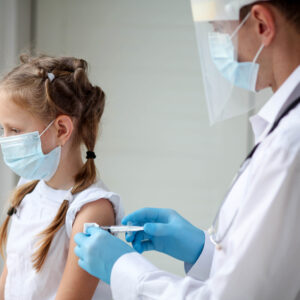Editor’s Note: For another viewpoint, see Counterpoint: Without FDA Approval, Vaccines Should Not Be Mandatory.
Our fear for our children’s safety is visceral, and it is universal.
Nothing unites people across all cultural, economic, social, and geographic lines like the love for their children and their desire to protect them against every danger, real or imagined.
So recent polls showing that one in four American parents don’t plan to get their children vaccinated against the coronavirus, whether with the newly approved shots for those at least 12 years of age or with the ones expected in September for little ones as young as 5, is not surprising.
When my son stopped moving for two hours in my wife’s womb after she fell on the stairs, when he got behind the wheel for the first time, when he drove off to college with a final wave goodbye — I felt something worse than fear. I felt helpless — helpless to save him from harm.
The mandatory vaccines Julian got at various ages before entering kindergarten — from hepatitis B (the only one given at birth), polio and pneumonia to diphtheria, tetanus, and influenza — came with reassurances from pediatricians that they’d been administered safely for decades, to millions of youngsters.
The COVID-19 vaccine is different. While it’s been provided to 157 million Americans, the vast majority are adults. The FDA only recently gave emergency authorization for children as young as 12 to receive it. Even for adults, the vaccines by Pfizer, Moderna, and Johnson & Johnson have not received final approval as federal and state health agencies collect more data on their effects.
And no vaccine in the history of medicine was developed with the lightning speed of the novel coronavirus inoculation — in the miraculous blink of nine months during last year’s pandemic shutdown. The other 16 or so shots that children receive on staggered schedules until adulthood took years to develop.
The coronavirus vaccine’s rapid development is cause for celebration — but also for pause from parents concerned about the 200 universities that have made vaccines mandatory for attendance this fall, and about the appeals by some principals, teachers, and administrators to require them for school attendance at much younger ages.
Only 53 percent of parents of children under 12, polled in May by Gallup, said they planned to have their kids vaccinated once the FDA green-lights it for younger people.
The scheduled September approval could put parents on a collision course with teachers and school administrators, who might insist on threat of union-led walkout that the vaccine be mandatory for their students.
But however natural their deep-rooted vigilance may be, the COVID-19 vaccine’s short but spectacular history should put parents’ hearts and minds at ease.
When Pfizer and Moderna announced last year that their hastily assembled vaccine trials had shown a 95 percent success rate, it seemed too good to be true. A year later, the news is still better: Among the 156 million Americans who have been fully vaccinated, scarcely 11,000 have contracted the virus. For the mathematically precise, that’s a success rate of 99.9999285714 percent.
Even more astounding, only 3,365 have required hospitalization, and of the 750 who have died, most were elderly or had underlying medical conditions.
“You are just as likely to be killed by a meteorite as die from COVID after a vaccine,” Dr. Peter Chin-Hong, an infectious-disease expert at the University of California in San Francisco, told CNBC.
That should be especially true for children, whose immune systems are more robust than those of adults, and whose rate of coronavirus infection has been a fraction of the rate of their elders.
If history is a guide, whether to make vaccines mandatory for schoolchildren will vary from state to state and even from district to district. And a glut of misinformation coupled with the burden of making a weighty choice can leave wary parents wanting to wait and see what happens to the herd.
That’s when children get sick.
“And when those who choose not to vaccinate live in the same communities, as a study out of Kaiser Permanente showed was the case in California, it can create the perfect environment for a vaccine-preventable germ to spread,” said Dr. Claire McCarthy, a primary care pediatrician at Boston Children’s Hospital and senior editor of Harvard Health Publications.
Older vaccines have all but eradicated 10 diseases that once killed children by the tens of thousands, with measles, diphtheria, and pertussis (whooping cough) leading the list of killers. Despite that success, Connecticut is the only state that requires all of them for kindergarten entry. Illinois, Alabama, Maine, Montana, Rhode Island, and South Dakota mandate only four.
“It’s always better to reinforce positive behavior rather than mandate,” Bob Bollinger, a professor of infectious diseases at the Johns Hopkins School of Medicine, told CNBC. “But we have a precedent of requiring vaccinations to go to school.”
Now the B.1.1.7 coronavirus variant, newly dominant in the United States, appears to be targeting younger patients more frequently, making it more urgent for them to be vaccinated.
Parents meeting this challenge must do what they do every day — overcome their fears in order to do what is best for their children.

